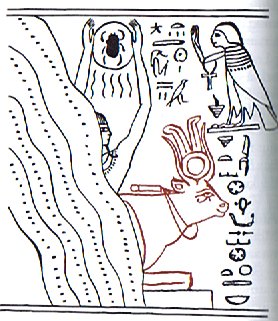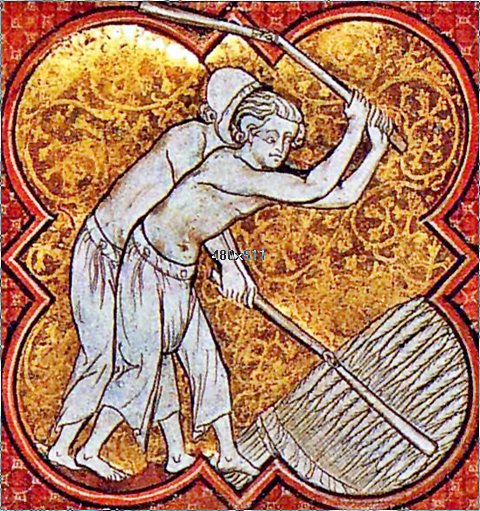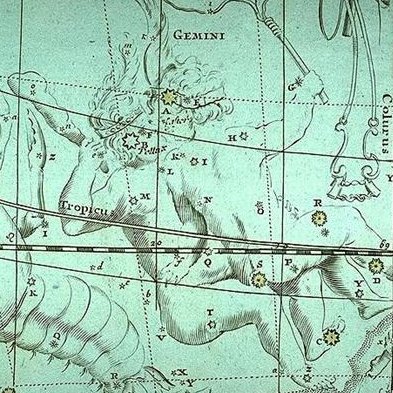There seems to have been a 'Standard Model' for the ancient cosmos, a structure which could explain everything. The Phoenicians divided the whole into a pair of halves, we can conclude from their alphabet:
I think the Phoenician alphabet could have been a reflection of the Egyptian figures in the night sky. Probably their first letter Alef was an ox because at the beginning of their sequence of star figures was Taurus. The female Hat-hor was the 'house' of Horus the morning sun and only her front half should therefore be visible (to indicate the idea of beginning):
... In the inscriptions of Dendera, published by Dümichen, the goddess Hathor is called 'lady of every joy'. For once, Dümichen adds: Literally ... 'the lady of every heart circuit'. This is not to say that the Egyptians had discovered the circulation of the blood. But the determinative sign for 'heart' often figures as the plumb bob at the end of a plumb line coming from a well-known astronomical or surveying device, the merkhet. Evidently, 'heart' is something very specific, as it were the 'center of gravity' ... See Aeg.Wb. 2, pp. 55f. for sign of the heart (ib) as expressing generally 'the middle, the center'. And this may lead in quite another direction. The Arabs preserved a name for Canopus - besides calling the star Kalb at-tai-man ('heart of the south') ... Suhail el-wezn, 'Canopus Ponderosus', the heavy-weighing Canopus, a name promptly declared meaningless by the experts, but which could well have belonged to an archaic system in which Canopus was the weight at the end of the plumb line, as befitted its important position as a heavy star at the South Pole of the 'waters below'. Here is a chain of inferences which might or might not be valid, but it is allowable to test it, and no inference at all would come from the 'lady of every joy'. The line seems to state that Hathor (= Hat Hor, 'House of Horus') 'rules' the revolution of a specific celestial body - whether or not Canopus is alluded to - or, if we can trust the translation 'every', the revolution of all celestial bodies. As concerns the identity of the ruling lady, the greater possibility speaks for Sirius, but Venus cannot be excluded; in Mexico, too, Venus is called 'heart of the earth'. The reader is invited to imagine for himself what many thousands of such pseudo-primitive or poetic interpretations must lead to: a disfigured interpretation of Egyptian intellectual life ... Cattle could be governed by a shepherd's staff, a Crook. At the end of the Land sequence was the Whip, Lamed. The whip (or flail) was like a crook (or club) an instrument for the ruler to make things happen. .. At the beginning of 44 B.C. - when Ceasar was still alive - the Senate decided to raise statues of him in all the temples and to sacrifice to him on his birthday in the month Quintilis, which in honour of him was renamed July. He was raised to the status of a god (among the other gods of the state) under the name Jupiter Julius. Marcus Antonius, who this year was consul together with Ceasar, became high priest and responsible for the ceremonies. In the middle of February, at the time of the old feast of Lupercalia, he ran around ... and whipped the Roman ladies with thongs made from goat-skin, in order to promote ... their fertility ... The triplicate strands of the Cat'o 9 Tails (or the Flail) were, though, otherwise the very opposite of the Crook. The Crook was at the beginning of Land, to drive the ploughing oxen, and the Flail at its end, at the beginning of Sea - possibly to activate the inundation to make Land fertile again. Osiris or Pharaoh ruled the whole Land.
... Wind winnowing is an agricultural method developed by ancient cultures for separating grain from chaff. It is also used to remove weevils or other pests from stored grain. Threshing, the separation of grain or seeds from the husks and straw, is the step in the chaff-removal process that comes before winnowing ... In its simplest form it involves throwing the mixture into the air so that the wind blows away the lighter chaff, while the heavier grains fall back down for recovery. Techniques included using a winnowing fan (a shaped basket shaken to raise the chaff) or using a tool (a winnowing fork or shovel) on a pile of harvested grain ... The winnowing-fan (λίκνον [líknon], also meaning a 'cradle') featured in the rites accorded Dionysus and in the Eleusinian Mysteries: 'it was a simple agricultural implement taken over and mysticised by the religion of Dionysus', Jane Ellen Harrison remarked. Dionysus Liknites ('Dionysus of the winnowing fan') was wakened by the Dionysian women, in this instance called Thyiades, in a cave on Parnassus high above Delphi; the winnowing-fan links the god connected with the mystery religions to the agricultural cycle, but mortal Greek babies too were laid in a winnowing-fan. In Callimachus' Hymn to Zeus, Adrasteia lays the infant Zeus in a golden líknon, her goat suckles him and he is given honey. In the Odyssey, the dead oracle Teiresias tells Odysseus to walk away from Ithaca with an oar until a wayfarer tells him it is a winnowing fan, and there to build a shrine to Poseidon ... If the kingship was divided, as in ancient Sparta, then the wooden staff could have been used by one of the rulers and the whip by the other:
In the Golden Age of Taurus the Gemini constellation came later than spring equinox. From the Gate of the Hyades to Castor there should have been around 113.4 - 64.2 = 49 days. According to our Gregorian calendar this would correspond to day 80 + 49 = 129 = May 9.
Why then have I counted with ºMay 9 as day 128? Maybe because ºNovember 7 (311) - 183 = 128. And RA day 52 - 4 = RA day 48 = 128 - 80. Anyhow, Castor was in rongorongo times at RA day 113.4 = July 12 = ºMay 9 (128) + 4 + 61. Caesar inserted 62 days between the month of Jupiter and the 7th month. Somewhere here could be the explanation of why 'October 15 (288) = Tagaroa Uri 15 (288) = the day when Hotu Matua arrived to Easter Island) came not 49 but 168 days after Ga1-2:
| ||||||||||||||||||||||||||||||||||||||||||||||||||||||||||||||||||||||||||||||||||||||||||||||||||||||||||||||||||||||||||||||||||||||||||||||||||||||||||||||||||||||||||||||||||||||||||||||||||||||||||||||||||||||||||||||||||||||||||||||||||||||||||||||||||||||||||||||||||||||||||||||||||||||||||||||||||||||||










